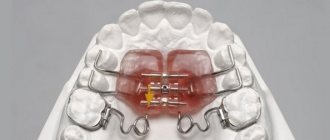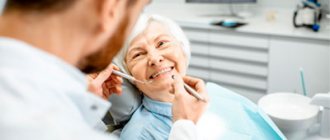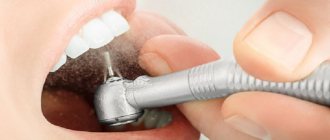11/24/2017 As you know, a person’s teeth grow twice throughout their life. By the age of 6-7 years, the primary bite is fully formed; by the age of 12-13 years, “children’s teeth” are replaced by “adult teeth” - by this time the formation of a permanent bite is completed. Somewhat later, up to the age of 20, 4 more “wisdom” teeth may grow. Their name reflects the late period of growth. They are the last in the row, but very often there is not enough space for them and their growth is associated with many problems.
Life cycle of teeth
Almost all the organs of our body are formed in the womb. Teeth are no exception. Already at the age of 6 weeks, the rudiments of the first teeth appear in the fetus: 10 pieces each. on the upper and lower jaw. Total - 20 small “buds”. This is the future milk bite.
See an interesting infographic about what kind of life our teeth live, and immediately after - in more detail about each stage and useful tips on how to preserve your teeth until old age.
Life cycle of teeth
| Birth | A child is born with fully formed tooth buds - they are located just under the surface of the gums. It is also interesting that some babies are already born with one or more teeth |
| 2-3 months | The baby begins to cut his first teeth. This is a rather unpleasant process, which is accompanied by excessive salivation, pain, deterioration of the child’s mood, and refusal to eat. In addition, during teething, local immunity is significantly reduced, which increases the risk of developing a viral infection. This explains the frequent increase in temperature during this period. |
| 6-14 months | Teeth begin to appear. The lower incisors grow first, then the upper ones. In total, the child should grow 20 pieces, including 2 multi-root chewing ones on each side - this will be the milk bite |
| 6-7 years | At this time, “baby” teeth begin to fall out. There is a change from a milk bite to a permanent one |
| 12-13 years old | The period of complete completion of the formation of a permanent dentition. By this age, the milky ones should fall out completely, and permanent ones should grow in their place. Helping teeth fall out in most situations is not required - this is a natural and physiological process that does not require third-party intervention. But it’s still worth seeing a doctor: it’s important to monitor both the wound and the process as a whole |
| 17-21 years old | During this period, “wisdom teeth” – the furthest ones in the row – may grow. There are 4 of them in total. There were no dairy predecessors in their place, so they have to pave the way on their own. In addition, they grow at a time when the bone tissue is fully formed and very hard. That is why their growth is associated with such problems as pain, acute inflammation of the mucous membrane, incorrect position in the row and even retention (the tooth does not erupt, forms and remains completely in the bone tissue) |
| 20 years and older | Starting at this age (and if there are problems with the body or when playing dangerous sports, even earlier), we begin to lose teeth. In the absence or poor hygiene, with poor nutrition, and the appearance of diseases of many organs and systems of the body, the enamel becomes weaker and is subject to attack by bacteria. With age, the amount of saliva decreases - and it is this that is a natural means of cleansing plaque. This is largely why teeth and gums become more susceptible to decay. It is also worth remembering that not only dental diseases, but also problems with gums lead to loss. |
Features of the development of dental tissue
The structure of each molar includes a crown - the outer part, a neck, as well as a root section, which ensures fixation in the bone tissue and nutrition of the element. The crown is covered with a protective layer - outer enamel, cement and dentin, designed to protect the pulp chamber from external influences. The sufficiency of nutrients entering the dental tissue depends on the condition of the pulp; in addition, it contains nerve endings that go to the root of the tooth, therefore, during inflammatory processes or damage affecting this layer, severe pain occurs. Age-related changes in dental tissue are an integral part of the natural aging of the body.
Interesting Facts
Enamel color
The natural color of enamel can be absolutely anything and it is extremely rare that it is snow-white. As a rule, the enamel is slightly yellowish or grayish. In children, teeth may even have a bluish tint, which indicates the presence of a large pulp and its close location to the enamel
About a child's first teeth
Some babies may be born with one or even more teeth, which form in the womb. It also doesn’t matter the age when the baby’s first teeth appear – at three or ten months. The main thing is that, in general, the milk bite is formed completely and correctly.
About the important role of baby teeth
Milk teeth serve primarily as the basis for permanent ones - they literally pave the way for them. If the first teeth grow straight, it is not at all necessary that the subsequent ones will grow as well. However, the opposite situation is also possible, so the formation and growth of all teeth should be monitored under the supervision of the attending physician.
About wisdom teeth
Wisdom teeth may not erupt – this is a completely normal and fairly common occurrence. Whether to remove or leave grown ones depends on their condition: if they only bring discomfort, in the presence of caries or pulpitis it is extremely difficult to cure them, it is quite possible to sacrifice such teeth, since they do not bear any functional load
About oral hygiene
According to statistics, only 57% of women and 46% of men cleanse twice a day. The rest periodically skip such an important procedure, which allows you to effectively cope with plaque and thereby protect the enamel and gums from attack by harmful bacteria.
About using dental floss
According to research, today only 50% of the population flosses daily. Meanwhile, this is an excellent way to prevent many dental diseases: it is the floss that effectively cleans the interdental spaces from food debris and plaque. Today, the only alternative to thread can be an irrigator - a brush cannot cope with such narrow spaces
Why are the first teeth called baby teeth?
There are several opinions on this matter. Doctors attribute the authorship of the term to Hippocrates, who believed that these teeth are formed from mother's milk. Philologist N.N. Vashkevich states that “the term is a tracing from the Latin lactose “milk”. But the tracing paper is false, it is a misunderstood Arabic liwaqt - “for a while,” “temporary.”
One way or another, the first teeth actually actively “feed” on breast milk, since it is from it that the child absorbs the main building material of teeth and bones – calcium. And although baby teeth erupt, as a rule, at 6-7 months, their formation in the child’s jaws occurs long before that.
It is worth noting that for the health and strength of the first teeth, it is mother’s milk (not cow’s) that is necessary, since the nutrients from it are maximally absorbed by the baby’s body. Therefore, the universal recipe “breastfeed your baby” will help in this matter.
Useful tips on how to preserve teeth from childhood
The most important requirements are regular hygiene and preventive examinations at the dentist.
It is very important for parents to develop the right habit in their child from childhood in order to maintain it for the rest of his life and protect his teeth from many dental problems. How to save teeth from childhood
| First visit to the dentist | The first visit to the dentist with your baby is necessary at the age of one year in order to make sure that the first teeth are growing and growing correctly. It is better to carry out medical examinations every six months, and after three years - every 3-4 months. This is explained by the fact that the tissues of baby teeth are quite soft and carious processes spread extremely quickly. |
| First visit to the orthodontist | You should visit an orthodontist for the first time at the age of 3-4 years. At this time, you can make the first attempts to correct the position of the jaws and elements of the dentition. Naturally, if there are serious congenital malocclusion pathologies, it is necessary to consult a doctor as soon as possible |
| When to start brushing your child's teeth | Hygienic procedures must be carried out from the moment the very first tooth appears. Many parents believe that cleaning can be neglected while the baby is on breast milk or until his firstborns are fully grown. But this is not so: the first teeth need especially careful hygiene - the growth and formation of a permanent bite largely depends on them. At the first stage, you can use a soft silicone cap, after 1-1.5 years - a baby brush with soft bristles, as well as a special paste selected according to age |
| Should a child get dentures? | Baby teeth not only need to be treated, but also replaced with children's dentures if they were removed too early. This will allow you to maintain the position of the others in the row and thereby form the correct permanent bite. |
| How often should you use a toothbrush? | You need to clean with a brush and paste 2 times a day: before breakfast and before bed, after all meals. In between, you need to use dental floss, irrigator and mouth rinse. |
| How often should you visit the dentist? | Adults need to visit a doctor every six months. Firstly, to examine the condition of the entire oral cavity, identifying problems at an early stage. Secondly, for comprehensive hygiene, which will better clean the enamel and gums from plaque |
Structure
The structure of a baby tooth is significantly different from a molar tooth. Its enamel and dentin are thinner, their layers are 0.1-1 mm and 0.5-1.5 mm, respectively.
They are much smaller in size than molars, but the incisors are more convex in shape. Their root canals are wider, which increases the risk of bacteria entering and multiplying with subsequent inflammation.
The pulp of the front and chewing milk teeth in children occupies a larger volume than in the molar; on this topic, you can find many photos about the structure of a child’s jaw, what it consists of, and diagrams of the roots of the dentition in an adult and a child. In addition, children's teeth are characterized by a low degree of mineralization, and therefore are more vulnerable to caries. By the way, even adults sometimes have baby teeth, but usually no more than one.
Age-related changes in dental pulp
Regressive and age-related changes in the dental pulp also affect dental health. Over the years, the pulp decreases, and fibrous changes are often observed in its tissues. Mineral deposition negatively affects the condition of blood vessels and capillaries. Atherosclerosis of pulp vessels occurs in many people over 50 years of age. Because of this, tooth tissues no longer receive proper nutrition, which is why they become more fragile and vulnerable. Many people are interested in how to determine a person’s age by looking at their teeth. Only a medical examination can provide more or less accurate data. It is very difficult to determine a person’s age by looking at their teeth, since even relatively young people’s teeth can be in very poor condition, and vice versa.
Clinical picture
The main symptom for all types of flux is severe toothache at the site of infection, sometimes diffuse (with extensive bone damage). Swelling gradually begins to increase: first it is localized above the site of inflammation, and then along the surrounding tissues, sometimes affecting the neck, temple and eye.
Important! Sometimes flux occurs painlessly or with a mild pain effect, which, as a rule, indicates the development of a chronic form with sluggish inflammation and periodic relapses.
Inflammation is accompanied by the following symptoms:
- pulsation at the site of the lesion;
- increase in body temperature to subfebrile and febrile levels;
- headache;
- enlarged lymph nodes on the affected side;
- weakness, lethargy, lack of appetite;
- pain when swallowing, talking, opening the mouth;
- pain when pressing on the gum;
- redness of the oral mucosa at the site of the lesion.
Age-related changes in bone tissue and gums
In addition to age-related changes in teeth, over the years a person, as a rule, decreases bone density and its height. Osteoporosis of the jaw often occurs in older people. The clinical picture is aggravated by adentia (partial or complete) and poor-quality dentures, due to which the distribution of the chewing load is disrupted. Changes can affect not only hard but also soft tissues. Age-related gum recession occurs both due to previous diseases (for example, periodontitis), and due to poor genetics, poor lifestyle and bad habits, especially smoking. At an advanced stage, this leads to loosening and loss of teeth.
When do baby teeth appear?
The rudiments of baby teeth appear in the embryo at about 5-7 weeks of pregnancy. By the time a child is born, the crowns of 10 temporary and 8 permanent teeth have already been formed in his jaws. The timing of the eruption of baby teeth is quite arbitrary. The average formula is as follows: the child’s age in months minus 6. That is, the first 2 teeth (usually the lower middle incisors) appear at 6-7 months, the next 2 (upper middle incisors) at 8-9 months. Next, the upper lateral incisors usually come out, then the lower lateral incisors, then the front molars, canines, and back molars. Thus, by the age of 2-2.5 years, the child should have all 20 milk teeth. These are ideal timing and ideal sequence; deviations from them are quite common. Teeth may begin to appear as early as 4 months, or may linger for up to 8-9 months. In rare cases, a baby is born with teeth already erupted.
If your little one doesn’t “meet the deadline,” don’t be alarmed. This does not mean that the child is developmentally delayed. You should also not be proud of the early appearance of teeth - it does not indicate the child’s superpowers. Early or late appearance of teeth may be a hereditary factor. In case of a strong deviation from the schedule - the appearance of teeth before 4 months or their absence after 9 months - just show the baby to the pediatric dentist. In general, the first examination by a pediatric dentist should be scheduled at least when the child is one year old. The doctor will see how the teething process is progressing and talk with you about the baby’s oral hygiene. The baby will get acquainted with the environment of the office, with the doctor, will get the first positive experience of visiting the dentist, because nothing unpleasant awaits him during this visit, and funny pictures on the walls of the clinic, toys, a chair in which he can ride with his mother - all this will certainly have an impact on him. him a good impression. From now on, you should take your child to the pediatric dentist at least twice a year.
How can you avoid age-related changes with the help of modern dentistry?
Even though our teeth age along with the rest of our bodies over the years, this does not mean that it is impossible to maintain an attractive and healthy smile in old age. Rule number one is good daily hygiene. Rule number two is regular preventive visits to the dentist. Professional cleaning will help remove hard plaque and prevent the development of caries, and the remineralization procedure improves the condition of the enamel. Laser and physical therapy are now actively used to strengthen gums, therefore, if you have problems with periodontal disease, it is recommended not only to visit a specialized specialist, but also to monitor the health of your gums at home. Rule number three is a balanced and healthy diet, coupled with taking vitamin complexes. This will help not only the teeth and oral cavity, but also other systems of the body.
Publisher: Expert magazine about dentistry Startsmile.ru
Author of the material: Yaroslav Ikonnikov
Eruption pathologies
What parents should be wary of when primary or permanent dental elements appear:
- delay in the eruption of the first teeth by 2 - 3 months. This may be a sign of the absence of primordia or a genetic predisposition;
- abnormally early dates. Possible disruptions in the functioning of the endocrine system;
- excessively dark enamel color. May be a consequence of chronic diseases or high iron levels in the blood;
- pathology of the bite or incorrect vector of tooth growth (rotation, tilt, displacement to the side). These signs indicate deformations of the dental system.










